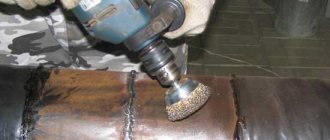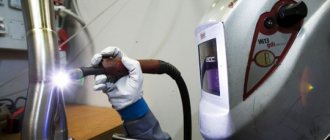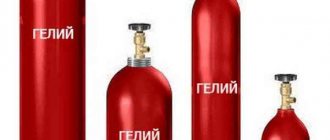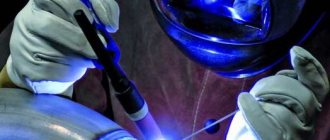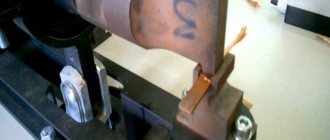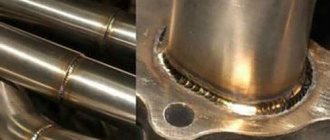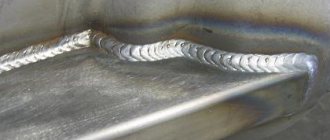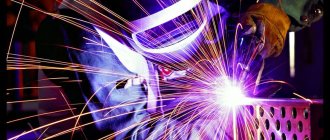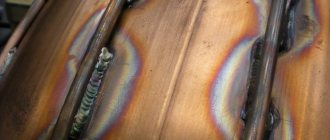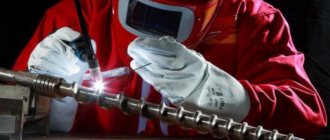In field conditions, when there is nowhere to connect to the power supply network, and it is not possible to use gas cylinders, it is advisable to resort to thermite welding technology. A simple and at the same time reliable method allows you to create strong welded joints.
The production and repair of metal structures almost always involves the use of welding equipment. However, it is not always fashionable to use traditional settings. For example, welding a large metal structure in the field will require thorough preparation and the issue of lack of electricity on the site will arise. If gas welding equipment is for some reason unavailable or unacceptable, then a good solution would be to join metals using thermite technology.
Thermite welding is a method of joining metal workpieces by burning thermite, a special powder composition consisting of metal oxide and aluminum. The mixture includes magnesium and aluminum powder, scale and metal additives.
Application area
Most often, thermite welding technology based on aluminum powder is used in cases of surfacing on structural elements, when it is necessary to join cast iron or other brittle alloys. The method is ideal for repairing railway tracks: it is inexpensive, can be done quickly and provides a strong connection with a long service life. All operations for welding railway rails are carried out in accordance with the requirements of GOST R 57181-2016.
Thermite technology is also in demand in other areas of production. For example, in mechanical engineering this is the most acceptable option for the manufacture of propellers for heavy-duty sea vessels. Most automotive crankshafts are made using this method. At enterprises associated with metalworking, thermite welding is used in the repair of rolling mills, rotary shafts and a number of other large-sized equipment and accessories.
Another important area where this technology is used is energy supply and data transmission. Large diameter cables are often used in communication and electricity transmission lines. To repair them and lay new lines, they resort to thermite welding. Consumables for such cases are made from magnesium.
Thermite welding technology
The production process is characterized by the fact that it does not require a connection to the power supply network or the supply of specific gas compositions. To connect metals, various powder mixtures are used: aluminum, iron oxide, magnesium. They are commonly called termites because during their combustion a large amount of thermal energy is generated.
High temperature affects metal workpieces, bringing them to a semi-liquid state. Due to a change in the state of aggregation, the metal of the workpieces is mixed with the melt of powder mixtures, forming a solid structure. The method of igniting the mixture needs clarification. To initiate the process, the temperature must reach 1350 degrees Celsius. To do this, you can use one of the three available methods. The first is using an electric discharge. It is not available in the field, so a more acceptable option would be to explode a squib or set fire to a special cord.
The combustion temperature of metal powder reaches 2400-2700 degrees Celsius. This is enough to melt most metals. It is important to pay attention to the fact that an influx of oxygen is not required to maintain the combustion process: it is sufficiently contained in the mixture itself. Therefore, thermite welding can be performed in an inert environment.
GENERAL INSTRUCTIONS
2.1.
Thermite cartridges for welding bare wires (Fig. 1) are manufactured:
a) PAS type according to GOST 18492-79, consisting of a thermite block pressed onto a steel tube and an aluminum liner. On the thermite sticks there is a red mark on the side (from the side of the loosest part) from which the thermite stick is ignited;
b) type PA according to TU 82-547-80, consisting of a thermite block with a vertical hole placed on a steel tube and caps or bushings placed on the wires to be welded;
c) type PM according to TU 84-496-74, consisting of a copper tube, a phosphorous copper liner fixed in it and a thermite cap pressed onto the tube.
Technical characteristics of thermite cartridges are given in appendices 2 and .
Rice. 1. Thermite cartridges of PAS types ( a
), PA (
b
) and PM (
c
)
1 - tube;
2 - thermite block; 3 - liner; 4 — ignition location; 5 - cap or sleeve; 6 — sprue hole 2.2.
The required heating temperature in the welding zone is obtained from combustion at temperatures above 2000 °C of thermite mass, consisting of combustible metal powder (magnesium) and iron scale.
2.3.
Ignition of the thermite checker of the thermite cartridge should be done from a special thermite match (manufactured according to TU 84-630-76), which has a combustion temperature of over 1000 °C.
A thermite match is a wooden stick (straw) on which an incendiary composition with an igniter at the end is applied (Fig. 2).
Rice. 2. Thermite match
1 - rubbing-ignition composition; 2 - incendiary composition
2.4.
Welding of wires should be done in one of the following ways (Fig. 3):
a) PAS thermite cartridges with wire supply to the welding zone - for steel-aluminum and aluminum wires;
b) PAS thermite cartridges with a drilled vertical hole with a metal additive and supply of wires to the welding zone - for steel-aluminum and aluminum wires;
c) PA thermite cartridges with a metal additive without wire supply - for aluminum and steel-aluminum wires;
d) PM thermite cartridges with wire supply to the welding zone - for copper wires.
Rice.
3. Methods of welding wires: a
- in PAS thermite cartridges;
b
- in PAS thermite cartridges with a drilled vertical hole;
c
- in PA thermite cartridges;
g
- in PM thermite cartridges; 1 — steel tube (for PM — copper); 2 - thermite block; 3 — sprue hole; 4 - aluminum liner (for PM - made of phosphorous copper); 5 — ignition location; 6 - asbestos seal; 7 - bandage that limits the one-way supply of wire to the welding zone; 8 - ends of wires to be welded; 9 - scraper made of sharpened steel wire; 10 - filler wire
2.5.
Devices for welding wires using thermite cartridges must be manufactured according to technical documentation approved in the prescribed manner and must be checked by the manufacturer's quality control department and tested before use (Appendix 4).
2.6.
The scope of welding of bare wires is given in table. 1 and in Fig. 4.
Table 1
Scope of welding of bare overhead line wires using thermite cartridges
| Weld location | Wires and their cross-section | Connection method | Recommendation for use |
| In the loops | Steel-aluminium, up to 240 mm2 | Without unloading welding points from tension | Should be applied |
| Steel-aluminium, 300 mm2 and more | Same | Should be used under strict welding quality control | |
| Aluminum, 16 - 800 mm2 | Without unloading welding points from tension | Should be applied | |
| Copper, 25 - 150 mm2 | Same | Same | |
| In the spans | Steel-aluminium, up to 185 mm2 | With unloading of the welding site from tension by twisting in oval joints | Can be used to improve contact reliability |
| Steel-aluminium, 240 mm2 and more | With unloading of the welding site from tension by crimping in SAS connectors | Same | |
| Aluminum, 16 - 240 mm2 | With unloading of the welding site from tension by twisting in oval connectors | Same | |
| Copper, 25 - 150 mm2 | With unloading of the welding site from tension by pressing in oval connectors | Should be applied |
Rice.
4. Scope of welding of bare wires: a
- in loops;
b
- in spans of aluminum and steel-aluminum wires with a cross-section of 35 - 185 mm2, twisted in oval connectors;
in
spans of copper wires with a cross-section of 25 - 150 mm2 crimped in oval connectors;
d
- in spans of aluminum and steel-aluminum wires with a cross-section of 240 mm2 or more with crimping in connectors; 1 - welding place; 2 - twisted oval connector; 3 — pressed oval connector; 4 - pressed connector
Kinds
There are two different methods of thermite welding - crucible and muffle. Their use is determined by the working conditions and the materials being connected. The first type of welding is also called aluminothermic and is used in the assembly of various metal structures and grounding loops. Thermite for this type of welding is prepared from aluminum powder and iron oxide. The ratio is 23:70 respectively. During the combustion process, iron is reduced from scale, the melt of which joins the workpieces.
In addition, aluminothermic welding is very often chosen for repairing metal surfaces using the surfacing method. The main advantage of this method is the ability to connect cast iron blanks without joints. It is impossible to form seams on aluminum elements using this joining method. To connect them, it is better to resort to another type of welding.
For muffle welding, magnesium-based thermite is used, since aluminum evaporates under high temperature. Magnesium has a high melting point, so it does not spread on the surface. The result is a strong welded joint without a seam. When aluminum billets are welded, a special flux is used to get rid of the oxide layer.
Thermite welding is performed in one of four ways:
- Butt. Thorough preparation is required in advance. The surface of the workpieces is thoroughly cleaned. To avoid unwanted deformation of the workpieces, the parts are wrapped with a special film. After the thermite burns, a melt is obtained. From the crucible it is poured into the joint space between two workpieces. The parts are tightly compressed together.
- Intermediate casting. The technique is used to connect parts fixed in a certain spatial position. This is the simplest connection option. The melt pre-prepared in the crucible fills the space between the two workpieces.
- Combined. The method combines two types of welding. Used for repairing railway tracks. The ends of the rails are pre-cleaned, after which the joint is formed using metal mold plates. A closed cavity is formed into which the melt is poured. The rails are compressed. After the melt has solidified, the joint around the perimeter is boiled again.
- Duplex. Classic crucible welding plus additional crimping of joints.
Cooking process
Thermite welding requires the presence of a special tool.
Crucible for thermite welding.
In addition, to carry out the work, the master will need:
- crucible with attached drain;
- A thermite pencil is necessary to perform thermite welding at home. It does not require heating, firing or melting. Once the equipment is connected to the network, work can begin;
- fasteners for parts being welded to support and hold them together;
- a metal saw, a torch for a welding machine, a thermometer and other items that may be needed for work.
A diagram of welding work with thermite for rails, cables and other elements may look like this:
- duplex;
- end to end;
- mixed;
- with intermediate injection.
The thermite welding process is used in cases where it is necessary to attach different surfaces, cathode and drain leads, or other similar parts to each other. Before you start welding metal, the parts themselves must be fired in a furnace.
It is important to note that the thermite must be fired separately. Then the parts to be welded are put under a press and treated with a special thermite substance. At this stage, the edges and ends of the surfaces are carefully processed, which makes it possible to use it at home.
To weld rails, switch mechanisms and other parts, you can use mixed technology. It combines butt welding and infusion welding. Before starting the process, the part to be welded must be protected with a steel plate using a press.
A gap will appear at this place, into which thermite of a liquid consistency is poured. After it hardens, the seam is processed and welded.
Compositions
The most popular is iron-aluminum thermite welding. Thermite's composition is dominated by iron oxide. There is also aluminum in the mixture, but its part is low and amounts to 25%. In addition to the main ingredients, there are also additional ones - iron cutting, flux, alloying additives and others. The thermite burns in a magnesite crucible, and the metal melts here. In addition to aluminum, the mixture may contain other components. So with iron oxide it can be used:
- magnesium – 31%;
- silicon – 21%;
- calcium – 43%;
- titanium – 31%.
The type of mixture depends on the area of use of welding. The simplest is iron scale combined with aluminum powder. It is important to strictly observe the proportions of the components. To repair railway tracks, a special composition called “rail” is used. In aluminothermic welding, a charge with a steel filler consisting of graphite chips and ferromanganese is used. To join alloy steels, a special composition is used, to which ferrotitanium and ferrovanadium additives are added.
Welding cast iron involves special requirements. Thermite intended for joining cast iron parts must contain silicon. If all requirements are met, a strong and durable connection is obtained. There is no manganese in cast iron welding additives.
Safety precautions
Regulatory acts indicate that, despite its apparent simplicity, thermite welding is a complex and dangerous type of work. Let's consider the security requirements:
- Thermite powder can only be stored in heated, ventilated areas;
- Do not use wet thermite;
- If welding work is carried out outdoors, then the joint area is cleared of snow, dirt and other foreign bodies to a diameter of 50 centimeters;
- Welding cannot be carried out if the thermometer drops below 10 degrees;
- You cannot ignite the charge from an arc;
- Instructions for using thermite inverters require filling the thermite with sand when burning, equipping the oxygen line with an additional safety valve and turning off the supply of the combustible mixture if the burner breaks down;
- The welder must be dressed in a special suit.
You can buy equipment for thermite welding in a special store; its price depends on the type and brand of inverter. For example, the price of such a welding machine in Voronezh and Krasnoyarsk starts from $500.
Thermite Welding Equipment
Technologically, the process is not difficult. However, for the reaction to proceed normally and to obtain the desired result, special tools and equipment are required:
- Crucible. It is made either from refractory metal or ceramics. The reservoir must ensure safe discharge of molten metal.
- Molds and dies will be required to create castings. They can be disposable or long-term use. To prevent the liquid metal from spreading, the surface of the mold is coated with special clay for thermite welding.
- Vices, clamps and other similar devices for compressing parts of molds.
- Thermite pencil. Required in many welding or metal cutting operations.
- Abrasives for cleaning the surface of the welding zone. This could be a grinder with a grinding wheel, sandpaper, or a metal brush.
- A set of auxiliary tools: strip thermometer, metal saw, gas torch, oxygen torch and others.
Conditions
They are extremely simple:
- the volume of thermite required to completely melt the joints and all components involved in the chemical reaction is calculated in advance;
- when using a charge (a loose form of the thermite mixture), you should make sure that all ingredients have a similar consistency and are mixed until homogeneous;
- the temperature pulse must be at least 1350 °C.
The active phase of the chemical reaction lasts no more than 30 seconds : liquid metal fills the gap, and unburned residues form slag.
Thermite welding of wires
The method is excellent for connecting multi-core cable lines made of aluminum or copper. Compared to mechanical joining methods - twists, blocks and other options - thermal welding has the advantage of lower electrical resistance of the joint. This effect is achieved by increasing the cross section. Before welding, the ends to be joined should be thoroughly cleaned and degreased. This is a necessary condition for obtaining a high-quality joint.
Special thermal cartridges are used to connect cable systems. They have a simple structure and consist of a mold and an insert. There are differences in the design depending on the material of the cores. If it is necessary to connect an aluminum stranded wire, including wiring with a steel core, a split-type steel die is used. Aluminum insert. Cartridges designed to work with copper lines have a mold made of sheet copper, and the liner is made of an alloy of copper and phosphorus. Heat energy is required to connect the wiring. It is generated by a thermite block, which is pressed onto the mold.
After each operation, a little cleaning of the liner is required. Namely: you need to remove the oxide film from its inner surface with a brush.
Advantages and disadvantages
Advantages of the technique:
- Easy to do.
- Thermite mixtures, when burned, form metal compositions that are durable and reliable.
- The equipment does not require large amounts of electricity and is mobile due to its low weight and dimensions.
Negative qualities:
- Before soldering, a number of preparatory work is carried out;
- There is no visual control of the process; only professional performers are allowed to work.
The work is carried out in an open area or in large areas , since when burned, thermite mixtures emit a lot of heat and light.
Aluminothermic rail welding
The process can be divided into several stages. The amount of thermal energy that will be released by the termite is preliminarily calculated. In accordance with the calculations obtained, the composition of the thermite mixture is selected. It is important that the mixture is homogeneous and all components are evenly distributed throughout the entire volume. Next, the mixture is set on fire, the temperature is brought to 1350 degrees Celsius.
Thermite turns into melt quickly - in about 20-30 seconds. Its mass is approximately half of the total volume of the mixture. Everything else is additional inclusions that settle as slag. Since the metal is heavier, it will occupy the lower part of the crucible, and the slag, accordingly, will be forced to the top.
The main difficulty in rail repair lies in the field nature of the work. In addition, the device for welding rails is very massive. However, this is the most acceptable option for repairing the railway track. Initially, the ends of the future joint are prepared. The edges are aligned and the gap is adjusted to 2-3 centimeters. Two rails are installed in the same plane. In this case, it is necessary to ensure precise alignment of the elements. Afterwards the mold is set and welding work begins.
Naturally, everyone would like to achieve the highest quality results from thermite welding. To translate a desire into an actual result, precise calculations will be required. It is necessary to select a sufficient volume of thermite so that the melt completely fills the opening between the blanks. It is very important that the mixture is perfectly mixed and all components are evenly distributed throughout the volume. At first the temperature will be 1400 degrees Celsius. At lower temperatures the thermite will not ignite.
Briefly about the history of development
For the first time, thermal welding was used to repair rails in 1915, and already 8 years later in the capital, all tram overpasses were repaired only by this method, using imported thermite. In 1925, Russian engineer Mikhail Aleksandrovich Karasev patented domestic thermite and organized its production in Moscow .
Thanks to domestic thermite, which was much better than imported options, the rails were welded to a higher quality, and the seam lasted much longer. As a result, over 100 thousand joints on tram tracks were restored.
In those distant times, repairs were carried out in two ways: by wedging and by a combined method. The first option quickly failed under constant load, so they abandoned it and began to use duplex - intermediate casting with pressing of molten metal.
The quality was constantly improving - the number of burst joints over 10 years of operation did not exceed 0.8%, so similar methods began to be used during the construction of the Moscow metro. The original technique began to be used for welding joints of high-pressure pipes, where special strength alloy steel was used . Thermites were used to repair large diameter shafts and other large metal parts.
